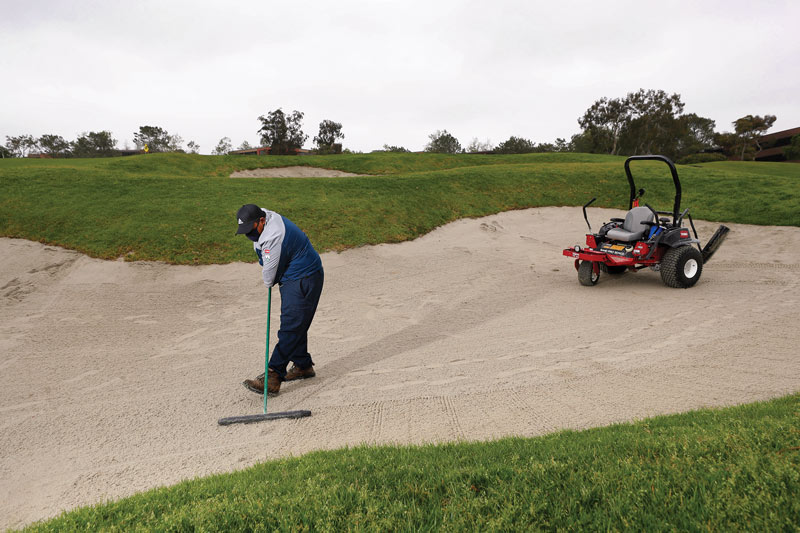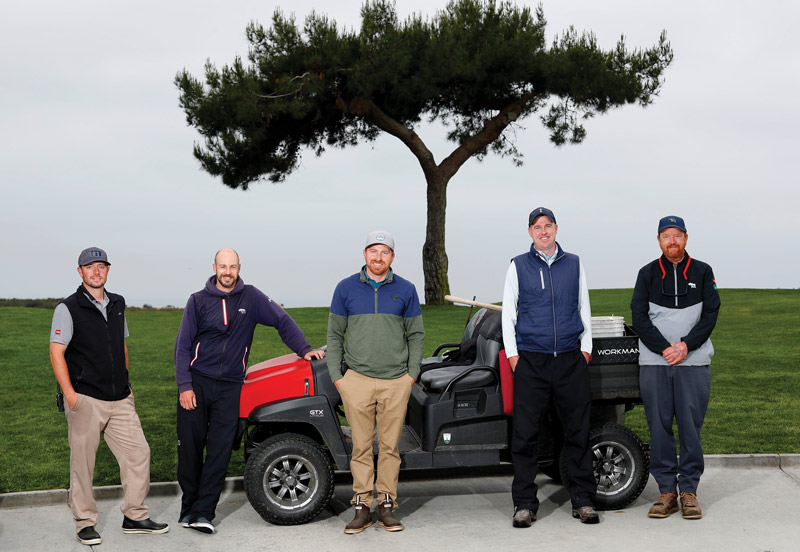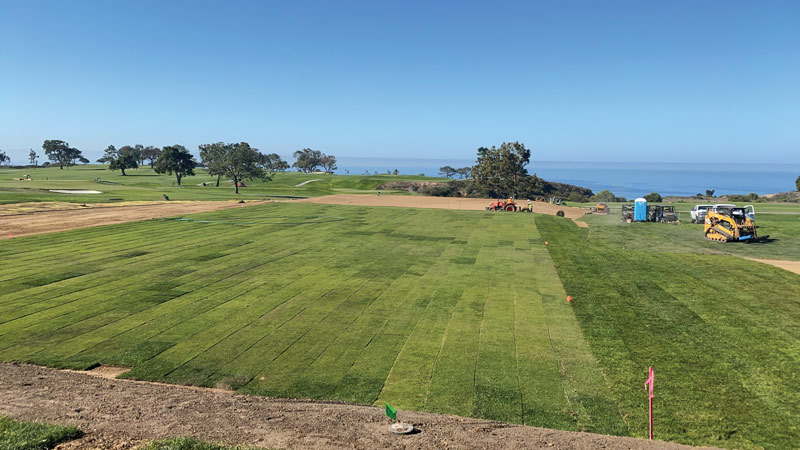
Named for a rare tree that only grows wild in Southern California, Torrey Pines opened in 1957 and is home to two 18-hole courses, the North and South. Photo by K.C. Alfred
Rich McIntosh wasn’t the only thing that rolled into Torrey Pines Golf Course in San Diego during McIntosh’s first visit to the property.
His initial steps onto the South Course were kind of, well, murky. “Fog rolled in. I think we had a two- or three-hour delay because the third and fourth holes were in dense fog,” McIntosh says, “but everywhere else, it was sunny.”
McIntosh had been invited to Torrey Pines as a maintenance crew volunteer for the PGA Tour’s annual Farmers Insurance Open in 2014. For McIntosh, then senior assistant superintendent at Muirfield Village Golf Club in Dublin, Ohio, the trip was a no-brainer. “January in Ohio or Southern California? I took advantage of it,” he says.
It’s perfectly clear now that McIntosh’s first impression of Torrey Pines wasn’t nearly as important as the lasting impression he made. McIntosh was invited to volunteer again the following year, and nine months later, he returned — this time to stay. McIntosh, now senior superintendent, was hired in October 2015 at Torrey Pines, a venue that’s continuing a renaissance two decades in the making.
Several key players have emerged in that venture: the city of San Diego, past GCSAA presidents, a local golfer who played in a major, the USGA, the PGA Tour and The Toro Co. Torrey Pines’ evolution was produced one hire, one decision at a time, and the 121st U.S. Open June 17-20 will be the second pro event this year at the South Course, which in January hosted the Farmers.
Editor’s note: Read all about the formidable kikuyugrass rough at Torrey Pines and hear from the agronomy team about managing it in Maintaining kikuyugrass at Torrey Pines.
“I can by no means take the credit for everything that has happened here,” says McIntosh, 36, a GCSAA Class A superintendent and 11-year association member. “I know a lot of people put in a lot of work to make it possible.”
A momentous 2008 U.S. Open
While McIntosh was playing soccer for the Medina, Ohio, High School Battling Bees, an agronomic dream team was taking shape in 2001 at Torrey Pines.
That’s when architect and 2004 GCSAA Old Tom Morris Award recipient Rees Jones was hired by the Friends of Torrey Pines organization to redesign the South Course. The goal was to upgrade Torrey Pines with the hope of landing a major.
Mark Marney, who had started with the city of San Diego in project management, was assigned to oversee golf after Jones completed his work. In 2002, the USGA awarded Torrey Pines the 2008 U.S. Open. Then, in 2005, Ted Horton, CGCS, a 54-year GCSAA member and winner GCSAA’s Col. John Morley Distinguished Service Award in 2019, was brought in as a consultant. Horton determined course maintenance needed to be addressed. “At the time, they were three years away (from the U.S. Open). They had to get consistent surfaces,” Horton says.

The South Course at Torrey Pines averages 70,000 rounds per year. Photo by Bill Hornstein/courtesy of the USGA
San Diego hired Mark Woodward, CGCS, as golf operations manager for city courses in 2005. Marney, meanwhile, assisted Woodward in developing a business plan for then-Mayor Jerry Sanders. “The goal was to get the course in championship condition and generate enough revenue to make the course self-sustaining,” says Woodward, a 42-year association member, GCSAA president in 2004 and its CEO from 2008 to 2010. (Woodward recently retired as director of agronomy at Whisper Rock Golf Club in Scottsdale, Ariz.)
It was a tumultuous stretch for Woodward, whose business plan clashed with some stakeholders. A turning point occurred in 2006, when Mayor Sanders mentioned he’d been hearing more about the golf course than the pension deficit. He grabbed pages of Woodward’s plan, held them up during a meeting with Woodward, and, as Woodward recalls, said, “What do I have to do to get ready for this U.S. Open?” “My whole world changed,” Woodward says.
In 2007, another former GCSAA president, Jon Maddern, CGCS, was hired as assistant deputy director of golf. “We got the staff and equipment where we needed it to be. The biggest thing I saw was a matter of coaching and teaching the staff what needed to be done and why,” says Maddern, GCSAA president in 2003, a 44-year association member and currently senior regional director of agronomy for ClubCorp. “You can’t be great unless you have the staff to do it. Mark (Woodward) and I were not going to fail. We were two former GCSAA presidents that hadn’t hosted a major. We were going to show everybody we weren’t better than them, but we were going to pull this off.”
What happened on June 16, 2008, is memorable for multiple reasons. It confirmed the maintenance department at Torrey Pines (featuring then-South Course superintendent Candice Combs) was effective, and it saw the conclusion of one of the most dramatic U.S. Opens ever. Woodward was invited by the USGA to walk inside the ropes for part of the playoff between Tiger Woods and Rocco Mediate. “Here I am, a 12-handicap guy, inside the ropes with 25,000 people lining the fairways. It was pretty special,” Woodward says.
Woods birdied the 72nd hole to force that 18-hole playoff, then birdied the last hole in the playoff to extend the match, which he won on the first sudden-death hole — doing it with a fractured tibia and ruptured ACL. Golf Digest ranked it No. 2 on its list of 15 best U.S. Opens, behind Arnold Palmer’s seven-stroke final-round rally to triumph in 1960 at Cherry Hills Country Club in Cherry Hills Village, Colo.
Relive Woods’ do-or-die putt at the 2008 U.S. Open in front of a raucous gallery surrounding the 18th green at Torrey Pines:
The spectacle also signaled Torrey Pines had no intention of being a one-and-done major venue. “We proved to the (PGA) Tour we could sustain what had been done, improve the system, make things long-term, more predictable, and have the USGA come back and give us another look,” Marney says.
Carolyn Wormser, who oversaw special events for San Diego from 1990 until 2020, says golf operations and the city stepped up to place Torrey Pines on solid footing. “I think the civic leaders, elected officials, rallied together for ways to improve the golf course. They truly had a vision, and they’ve been able to stay focused and elevate. Sometimes you just need a nudge,” says Wormser, now director of championship relations for the USGA. “All the city employees that support the golf course are mindful they are stewards of the special and treasured community asset that is Torrey Pines Golf Course. I think the city really values Torrey Pines. It’s an incredible opportunity to showcase a public facility and what the talent of our public employees can do.”
McIntosh credits Woodward, Marney and others who blazed the trail upon which his team now walks. “Those guys did a lot of heavy lifting and put us in position to be successful and carry the torch,” McIntosh says.
A superintendent career unfolds
That same month 13 years ago when Woods persevered at the U.S. Open, McIntosh graduated from Ohio State University. It was an especially momentous occasion for parents Rich and Jan McIntosh. “Mom still would tell you she didn’t think I’d go to college,” McIntosh says. “I used to be a big procrastinator.”
After two years in the architecture program, he switched to the turfgrass curriculum and got his feet wet as an intern at Muirfield Village under director of grounds Paul B. Latshaw, CGCS. McIntosh made a splash.
“He has an infectious smile, always positive, an overall can-do attitude. He’s one of those you just know is going to be successful, is passionate and driven and won’t settle for mediocrity,” says Latshaw, a 33-year GCSAA member who is now director of golf course operations at Merion Golf Club in Ardmore, Pa., and continues to watch McIntosh grow on the West Coast. “The more pressure, the better Rich is. Two tournaments in one year? That’s a lot of work. If you don’t love it, you can’t fake it.”

Torrey Pines Golf Course senior superintendent Rich McIntosh. Photo by K.C. Alfred
Mark Marney returned to Torrey Pines in 2010 as deputy director of the golf division. He’d left San Diego in 2008 for a job with the city of San Jose. His comeback would be crucial to McIntosh’s climb. To boost the facility’s volunteer corps for the Farmers, Marney instituted a program that lured highly regarded assistants to join the maintenance crew during the tournament. Paul Vermeulen, PGA Tour director of competitions agronomy, who at one time was assigned to Torrey Pines for the Tour event, did the same at Muirfield Village for the Memorial Tournament presented by Nationwide. That’s where he was introduced to McIntosh.
When then-Torrey Pines superintendent Blake Meentemeyer exited in May 2015 to become the USGA’s West Region agronomist, he left with fond memories and had also observed McIntosh excel. “He was one who got along with everybody. I learned from Randy Wahler (CGCS Retired, who was at Knollwood Club in Lake Forest, Ill.) that in our business it’s 25% turf, 25% business and 50% people and communications. Rich has got those qualities,” says Meentemeyer, a 17-year association member who is now the director of golf course operations at TPC Scottsdale. “For me, when I was there was perfect timing. I had an opportunity to up the standards, take things to the next level. I can’t tell you how proud I was to help make changes there, be able to work beside a crew, with a staff that bought into a new way of doing things.”
McIntosh applied for the opening and got a phone interview. “I didn’t hear anything for months. I kind of forgot about it,” McIntosh says. Torrey Pines, though, hadn’t forgotten about him. On Oct. 12, 2015, McIntosh began his first day as superintendent of Torrey Pines. A week later, it was time to overseed. He was on a mission.
“I worked myself into the ground. The last thing I was going to do was fail,” says McIntosh, who was driven to succeed by people such as Latshaw, Vermeulen, PGA Tour agronomist Chuck Green (who now does the Farmers) and former co-workers such as Jacob Gargasz, a GCSAA Class A superintendent and 18-year association member at Crooked Stick Golf Club in Carmel, Ind. “I was going to make sure my first tournament was successful.”

Grounds maintenance worker Moises Sandoval on bunker duty at Torrey Pines. Photo by K.C. Alfred
That attitude is what Lucas Lownes would expect. McIntosh was the first intern Lownes, then an assistant under Latshaw at Muirfield Village, hired. “By the third day, I knew that this kid was going to be special,” says Lownes, a GCSAA Class A superintendent and 19-year association member at Aspetuck Valley Country Club in Weston, Conn. “He has a good work ethic and a good head on his shoulders. It isn’t always about book smarts. Sometimes it’s about common sense and a gut feeling and sticking with it. Rich has got that in him.”
As for the procrastinator stuff, that’s history. “If I was a procrastinator, I wouldn’t be successful here,” McIntosh says. “You’ve got to think months ahead. If you’re going to see curveballs, you’ve got to get ahead of it and be prepared.”
Prioritizing agronomy at Torrey Pines
Forty years ago, Scott Bentley ritually met friends for golf at Torrey Pines. There was a catch, however.
“Monday, Wednesday and Friday were the days they mowed greens and changed cups. You wanted to be first out on fresh greens and cups,” says Bentley, city champion in 1980, Southern California PGA Section champion in 1990 and PGA Championship qualifier in 1991. Bentley played in the Farmers three times, making the cut in one 31 years ago.
Today, Bentley is entrenched in the Torrey Pines dream team. Hired in 2010 as golf course manager, now he is deputy director of the city’s golf division. He worked under Marney, who retired in 2020, and the handoff, it would appear, was seamless.
“They protect me from the political side of it and let me take care of the golf course while they navigate the waters of the city,” McIntosh says. “A lot of what they have done is about educating people working for the city, keeping lines of communication open with them and letting them know what we need.”

Grounds team leaders at Torrey Pines (from left): Devin Cullen, assistant superintendent; Tim Phelan, assistant superintendent; Travis Rebischke, assistant superintendent; senior superintendent Rich McIntosh; and Rob Browns, superintendent. Photo by K.C. Alfred
Marney and Bentley took steps over a lengthy period to bolster the agronomy department. “Executive management in the city was very supportive, but we still had to navigate the process,” Marney says. An example: In 2017, after multiple years of negotiations, the city fulfilled a crucial need. The Toro Co., along with its distributor Turf Star, finalized a 12-year equipment and tournament-support agreement with San Diego. Marney also prevailed when he worked at enhancing compensation for his superintendents. Nothing happened in a minute, but he was willing to put in the hours.
“The biggest hurdle coming into a municipal environment is labor issues,” Marney says. “It’s a union facility, and with that comes things you need to be aware of, what job classifications are, following certain protocols, and that things don’t happen as fast as you want them to. Rich was here for the end of the Toro deal being done, and upgrading his position, the North and South course renovations in 2016 and 2019, respectively, and the learning curve it brings. The U.S. Open is attractive for young talent, but you still have to deal with the day-to-day leading up to it. Rich has been up to the challenge.”
Torrey Pines equipment manager Herb Leyva shares a peek inside the maintenance shop and at the equipment fleet for the U.S. Open:
City leaders, who continue to support and foster projects at Torrey Pines, recently huddled with John Bodenhamer, the senior managing director of championships for the USGA. “We met with the mayor (Todd Gloria) and his team,” Bodenhamer says. “I commended him and the city. They invested $14 million in renovating the (South) golf course. A lot of municipalities don’t do that, but they did. That’s great for the U.S. Open, but it’s even better for the citizens of San Diego. They’re investing in it to make sure it remains modern and vital.” Bodenhamer notes the city has made clear that more USGA championships would be welcomed in the future.
Torrey Pines sure appears to be trending upward. Play has increased. Profits are sound. It hardly mirrors what Bentley remembers when it cost about $100 monthly for 20 weekday rounds. “It’s night and day from where it’s come from in my lifetime,” Bentley says. “We’re able to maintain at a high level. We truly appreciate our customer. People are happy. I think it resonates through the whole community. We raised the bar here and around the world.”
Living the dream
It all started with hand-watering greens as a volunteer at Torrey Pines. Nowadays, McIntosh has a firm grip on taking the facility to even greater heights. This is one of those pinch-yourself moments for him. “Never in a million years I thought I would be the superintendent at Torrey Pines,” McIntosh says.
Vermeulen disagrees. “They (Torrey Pines) got the pick of the litter with Rich,” Vermeulen says.
As Torrey Pines prepares to build on its legacy, McIntosh reminds anyone who may ask that his predecessors established a culture of excellence through perseverance. He says they deserve recognition for elevating the breathtaking facility situated on cliffs overlooking the Pacific Ocean.
Hang gliding is a big deal around there, and McIntosh is flying high. “We’re following others who were here before me to make this place as good as it can be and where it should be,” says McIntosh, who has staff members who were around in 2008. “My big thing is to produce the best playing conditions and never go backward.”
The 2021 U.S. Open: Golf course facts
The 2021 U.S. Open will be held June 17-20 on the South Course at Torrey Pines Golf Course in San Diego.
The grass
Greens: Poa annua maintained at .100 inch
Tees: Bermudagrass maintained at .300 inch
Fairways: Kikuyugrass maintained at .350 inch
Rough: Kikuyugrass overseeded with ryegrass, maintained at 3 to 5 inches
The course
Year built: 1957
Architects: William P. Bell and William F. Bell
Renovation: Rees Jones in 2001
Average green size: 5,000 square feet
Acres of fairway: 20
Acres of rough: 120
Number of sand bunkers: 82
Number of water hazards: 1
Number of holes on which water is in play: 1 (No. 18)
Soil conditions: Clay
Water sources: Potable (greens) and reclaimed (everywhere else)
Par: 35-36—71
Yardage: 7,685
- The Torrey Pine (Pinus torreyana) is a rare tree that grows in the wild only along a stretch of the coastline in San Diego County and on Santa Rosa Island.
- The facility sits on the northern part of what was formerly Camp Callan, a U.S. Army installation during World War II.
- Torrey Pines’ South Course averages 70,000 rounds per year.
- Unusually cold and overcast weather in the weeks leading up to the U.S. Open has made some preparation challenging.
Gearing up for the 2021 U.S. Open

Construction of temporary driving range tees on Nos. 1 and 18 of the North Course that will be used for the U.S. Open. Photo by Darin Bevard
If the South Course at Torrey Pines looks anything this month like it did on a recent visit from USGA Director of Championship Agronomy Darin Bevard, bank on a spectacular U.S. Open. “From tee to green, the place looked money,” Bevard says.
Senior superintendent Rich McIntosh and his team — including GCSAA Class A superintendent Rob Browns, a 22-year association member, and assistants Devin Cullen (a nine-year member), Tim Phelan (a nine-year member), and Travis Rebischke (a five-year member) — have been in tournament mode for a while, having hosted the Farmers Insurance Open in January.
“With the number of rounds they do (roughly 70,000 annually on the South Course) and the conditions they maintain, they are dialed in and very well-choreographed to get their work done on a daily basis,” Bevard says. “Rich is extremely professional, great to deal with, very organized in the approach to everything he does. It makes it a lot easier on me. And he genuinely is one of the nicest people you will meet.”
Meet some of the volunteer workforce who’ve helped get the South Course in top form ahead of the U.S. Open, and get a behind-the-scenes look at the week in course prep:
The South Course will look somewhat different in spots compared with when it hosted the 2008 U.S. Open. In 2019, architect Rees Jones oversaw renovations that included regrassing green surrounds, a handful of rebuilt tees and bunkers, and alterations to the par-4 fourth and 17th holes (the 17th now plays closer to the canyon edge). Additionally, a cross bunker was added at No. 9, the 10th and 15th holes were lengthened, and a modern irrigation system was installed.
The South Course features Poa annua greens, bermudagrass tees and approaches, and kikuyugrass fairways and rough. The rough may be in the 5-inch range, but that could be modified depending on how penal it becomes, according to Bevard, who is happy the championship has returned to its normal June date (it moved to September last year because of the pandemic).
McIntosh says he’ll add between 60 to 75 volunteers, probably all of them from the U.S. He’d hoped to invite a few from places such as the United Arab Emirates and Colombia, but the pandemic may prevent that from happening. Either way, Torrey Pines will be a happening spot. As he hosts his first major, McIntosh understands the magnitude of it, yet it’s also still business as usual. “Obviously, this is on a bigger scale,” he says, “but don’t get yourself too worked up over it. Keep doing what you’re doing.”
Howard Richman is GCM’s associate editor.